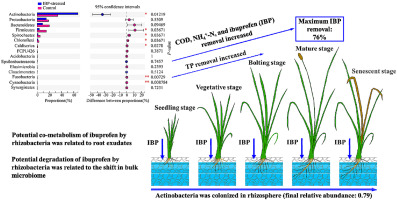当前位置:
X-MOL 学术
›
Chemosphere
›
论文详情
Our official English website, www.x-mol.net, welcomes your feedback! (Note: you will need to create a separate account there.)
Phytoremediation of pharmaceutical-contaminated wastewater: Insights into rhizobacterial dynamics related to pollutant degradation mechanisms during plant life cycle.
Chemosphere ( IF 8.8 ) Pub Date : 2020-04-05 , DOI: 10.1016/j.chemosphere.2020.126681 Yifei Li 1 , Jie Lian 1 , Bing Wu 2 , Hua Zou 1 , Soon Keat Tan 3
Chemosphere ( IF 8.8 ) Pub Date : 2020-04-05 , DOI: 10.1016/j.chemosphere.2020.126681 Yifei Li 1 , Jie Lian 1 , Bing Wu 2 , Hua Zou 1 , Soon Keat Tan 3
Affiliation

|
Rhizobacterial dynamics, relating to pollutant degradation mechanisms, over the course of plant lifespan have rarely been reported when using phytoremediation technologies for pharmaceutical-contaminated wastewater treatment. This study investigated the rhizobacterial dynamics of Typha angustifolia in constructed wetlands to treat ibuprofen (IBP)-polluted wastewater throughout plant development from seedling, vegetative, bolting, mature, to senescent stages. It was found that conventional pollutant and IBP removals increased with plant development, reaching to the best performance at bolting or mature stage (removal efficiencies: 92% organics, 52% ammonia, 60% phosphorus and 76% IBP). In the IBP-stressed wetlands, the rhizobacterial diversity during plant development was adversely affected by IBP accompanied with a reduced evenness. The bacterial communities changed dynamically at different developmental stages and showed significant differences compared to the control wetlands (free of IBP). The dominant bacteria colonized in the rhizosphere was the phylum Actinobacteria, having a final relative abundance of 0.79 and containing a large amount of genus norank_o__PeM15. Positive interactions were evident among the rhizobacteria in IBP-stressed wetlands and the predicted functions of 16S rRNA genes revealed the potential co-metabolism and metabolism of IBP. The co-metabolism of IBP might be related to root exudates such as amino acid, lipid, fatty acid and organic acid. In addition, positive correlations between the organic compounds of interstitial water (bulk environment) and the rhizobacterial communities were observed in IBP-stressed wetlands, which suggests that the influence of IBP on bulk microbiome might be able to modulate rhizosphere microbiome to achieve the degradation of IBP via co-metabolism or metabolism.
中文翻译:

药物污染废水的植物修复:对植物生命周期中与污染物降解机制有关的根瘤菌动力学的见解。
当使用植物修复技术来处理药物污染的废水时,很少有关于植物寿命过程中与污染物降解机制有关的根瘤菌动力学的报道。这项研究调查了人工湿地香蒲的根际细菌动力学,以处理布洛芬(IBP)污染的废水,从植物的整个发育过程开始,从幼苗,无性,抽ing,成熟到衰老阶段。研究发现,常规污染物和IBP的去除量随着工厂的发展而增加,在抽ing或成熟阶段达到最佳性能(去除效率:92%的有机物,52%的氨,60%的磷和76%的IBP)。在IBP胁迫的湿地中,植物发育过程中的根际细菌多样性受到IBP的不利影响,并伴有均匀度降低。与对照湿地(不含IBP)相比,细菌群落在不同发育阶段动态变化,并显示出显着差异。根际中定居的优势细菌是放线菌门,最终相对丰度为0.79,并含有大量norank_o__PeM15属。在IBP胁迫的湿地中,根际细菌之间存在明显的正相互作用,并且16S rRNA基因的预测功能揭示了IBP的潜在共代谢和代谢。IBP的共代谢可能与根系分泌物有关,如氨基酸,脂质,脂肪酸和有机酸。此外,在IBP胁迫的湿地中,观察到间质水(大量环境)的有机化合物与根瘤菌群落之间存在正相关,
更新日期:2020-04-06
中文翻译:

药物污染废水的植物修复:对植物生命周期中与污染物降解机制有关的根瘤菌动力学的见解。
当使用植物修复技术来处理药物污染的废水时,很少有关于植物寿命过程中与污染物降解机制有关的根瘤菌动力学的报道。这项研究调查了人工湿地香蒲的根际细菌动力学,以处理布洛芬(IBP)污染的废水,从植物的整个发育过程开始,从幼苗,无性,抽ing,成熟到衰老阶段。研究发现,常规污染物和IBP的去除量随着工厂的发展而增加,在抽ing或成熟阶段达到最佳性能(去除效率:92%的有机物,52%的氨,60%的磷和76%的IBP)。在IBP胁迫的湿地中,植物发育过程中的根际细菌多样性受到IBP的不利影响,并伴有均匀度降低。与对照湿地(不含IBP)相比,细菌群落在不同发育阶段动态变化,并显示出显着差异。根际中定居的优势细菌是放线菌门,最终相对丰度为0.79,并含有大量norank_o__PeM15属。在IBP胁迫的湿地中,根际细菌之间存在明显的正相互作用,并且16S rRNA基因的预测功能揭示了IBP的潜在共代谢和代谢。IBP的共代谢可能与根系分泌物有关,如氨基酸,脂质,脂肪酸和有机酸。此外,在IBP胁迫的湿地中,观察到间质水(大量环境)的有机化合物与根瘤菌群落之间存在正相关,



























 京公网安备 11010802027423号
京公网安备 11010802027423号